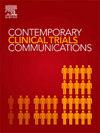评价针刺对产后肥胖妇女减肥的效果:一项随机对照试验的研究方案
IF 1.4
Q4 MEDICINE, RESEARCH & EXPERIMENTAL
引用次数: 0
摘要
孕妇在怀孕期间平均体重增加16.6±4.8 kg,产后6个月体重保持4 kg,产后12个月体重保持4 kg,产后18个月体重保持2.9 kg。分娩后3、6、9和12个月,分别有61.92%、68.73%、78.18%和84.24%的女性BMI恢复到正常范围。肥胖对产后妇女的身心健康有负面影响。先前的研究表明,针灸可能有助于减肥。本研究探讨了手工针灸(MA)治疗产后肥胖(PO)的有效性,并与假针灸(SA)进行了比较。方法多中心、随机、单盲对照试验。共有82名符合条件的PO参与者将以1:1的比例随机分配到MA (n = 41)或SA (n = 41)组。MA组采用针刺治疗,对照组采用假针刺治疗。两组均接受饮食和运动指导,每次治疗30分钟,每周三次,共8周。主要结局指标是治疗8周后与基线相比体重指数(BMI)的变化。次要结局指标包括基线至治疗4周的BMI变化,基线至治疗8周的腰围、腰臀比(WHR)、血糖、血脂水平、甲状腺功能和其他血清学指标的变化。次要测量还包括饮食和运动指导依从性量表,以及抑郁和焦虑状态的评估。在整个研究过程中,不断评估针灸的安全性。治疗后14周和20周随访。本前瞻性随机试验将有助于评估针灸治疗前列腺癌的疗效和安全性。本研究的结果将为针灸治疗PO的有效性提供证据。试验注册:ChiCTR2300067658,于2023年1月17日注册。本文章由计算机程序翻译,如有差异,请以英文原文为准。
Evaluation of the effect of acupuncture on weight loss in postpartum obese women: a study protocol for a randomized controlled trial
Background
Pregnant women gain an average weight of 16.6 ± 4.8 kg during pregnancy, with weight retention of 4 kg at 6 months, 4 kg at 12 months, and 2.9 kg at 18 months postpartum. At 3, 6, 9 and 12 months after delivery, 61.92 %, 68.73 %, 78.18 % and 84.24 % of women whose BMI returned to the normal range, respectively. Obesity has negative effects on postpartum women's physical and mental health. Prior research has suggested that acupuncture may be beneficial for weight loss. This study investigates the effectiveness of manual acupuncture (MA) for treating postpartum obesity (PO), compared to sham acupuncture (SA).
Methods
This is a multicenter, randomized, single-blind controlled trial. A total of 82 eligible PO participants will be randomly assigned to either MA (n = 41) or SA (n = 41) group using a 1:1 ratio. The MA group received acupuncture treatment and the control group received sham acupuncture treatment. Both groups received diet and exercise instructions and were treated for 30 min each session, three times a week, for a total of 8 weeks. The primary outcome measure was the change in body mass index (BMI) after 8 weeks of treatment, compared to baseline. Secondary outcome measures include changes in BMI from baseline to 4 weeks of treatment, changes in waist circumference, waist-to-hip ratio (WHR), blood glucose, lipid levels, thyroid function and other serological measures from baseline to 8 weeks of treatment. Secondary measures also included dietary and exercise guidance compliance scales, as well as assessments of depression and anxiety status. The safety of acupuncture was continuously evaluated throughout the study. Follow-up was performed at 14 and 20 weeks after treatment.
Discussion
This prospective randomized trial will help evaluate the efficacy and safety of acupuncture in treating PO. The results of this study will provide evidence of the therapeutic effectiveness of acupuncture on PO.
Trial registration
chictr.org.cn: ChiCTR2300067658, registered on January 17, 2023.
求助全文
通过发布文献求助,成功后即可免费获取论文全文。
去求助
来源期刊

Contemporary Clinical Trials Communications
Pharmacology, Toxicology and Pharmaceutics-Pharmacology
CiteScore
2.70
自引率
6.70%
发文量
146
审稿时长
20 weeks
期刊介绍:
Contemporary Clinical Trials Communications is an international peer reviewed open access journal that publishes articles pertaining to all aspects of clinical trials, including, but not limited to, design, conduct, analysis, regulation and ethics. Manuscripts submitted should appeal to a readership drawn from a wide range of disciplines including medicine, life science, pharmaceutical science, biostatistics, epidemiology, computer science, management science, behavioral science, and bioethics. Contemporary Clinical Trials Communications is unique in that it is outside the confines of disease specifications, and it strives to increase the transparency of medical research and reduce publication bias by publishing scientifically valid original research findings irrespective of their perceived importance, significance or impact. Both randomized and non-randomized trials are within the scope of the Journal. Some common topics include trial design rationale and methods, operational methodologies and challenges, and positive and negative trial results. In addition to original research, the Journal also welcomes other types of communications including, but are not limited to, methodology reviews, perspectives and discussions. Through timely dissemination of advances in clinical trials, the goal of Contemporary Clinical Trials Communications is to serve as a platform to enhance the communication and collaboration within the global clinical trials community that ultimately advances this field of research for the benefit of patients.
 求助内容:
求助内容: 应助结果提醒方式:
应助结果提醒方式:


